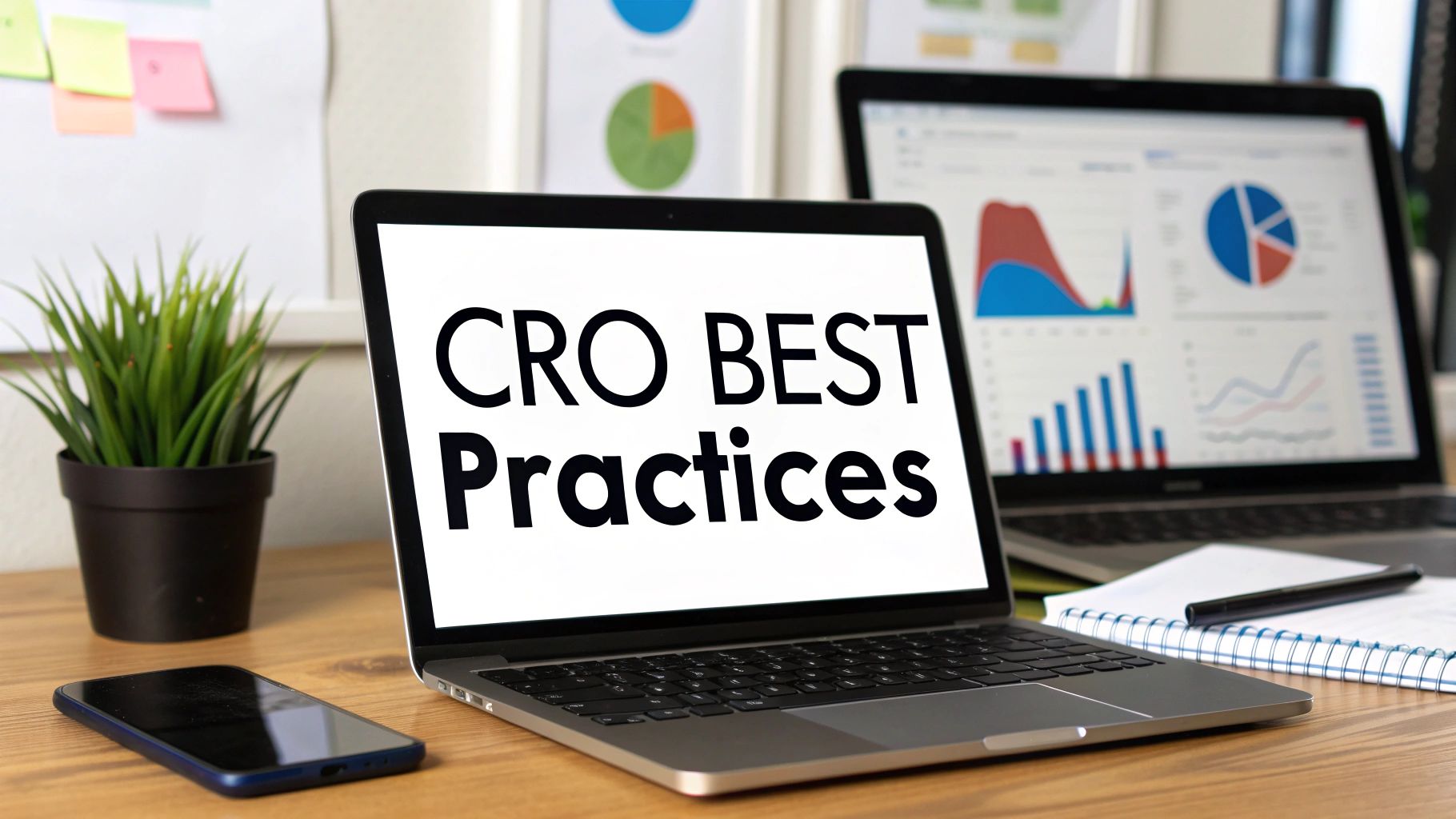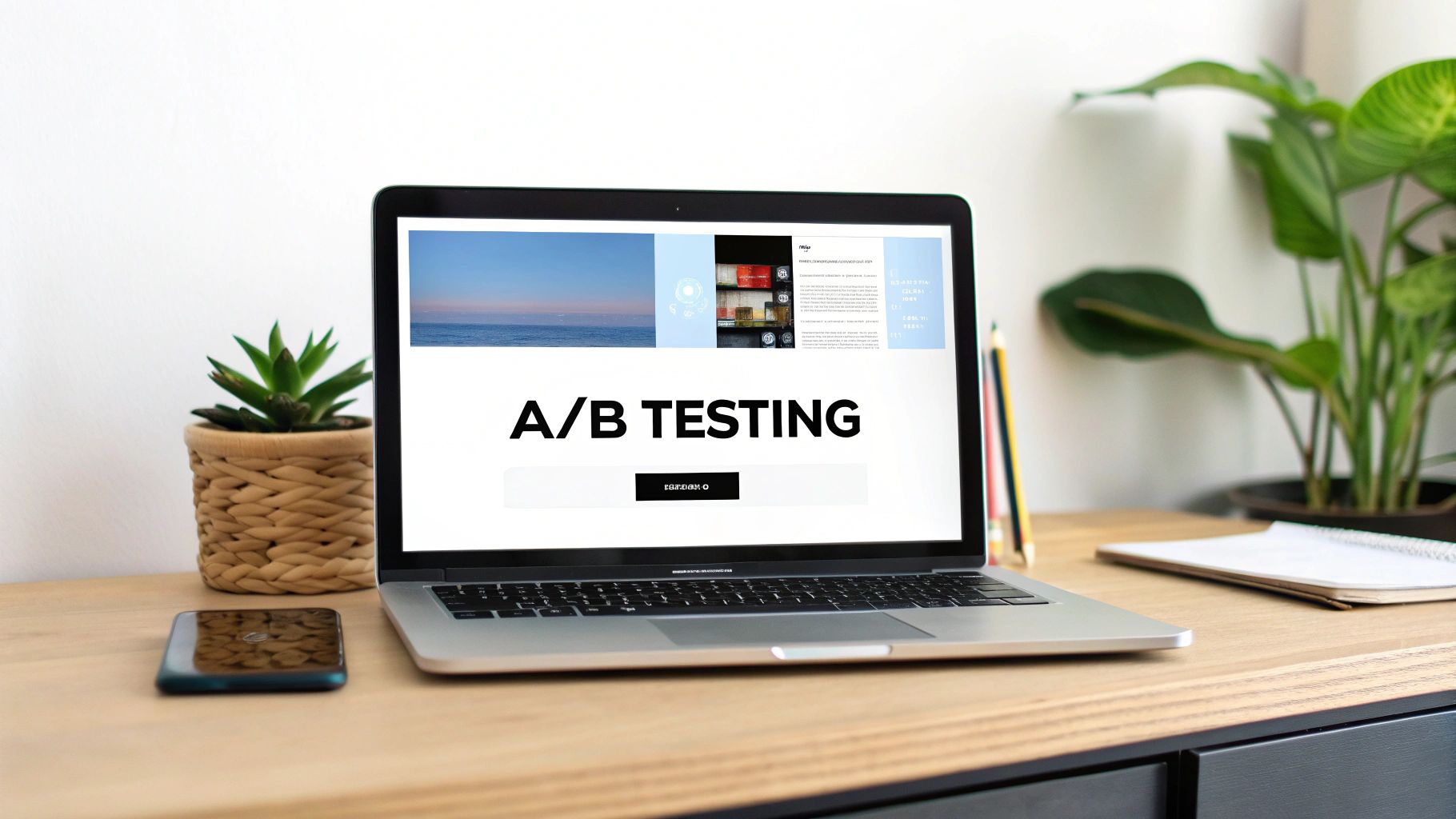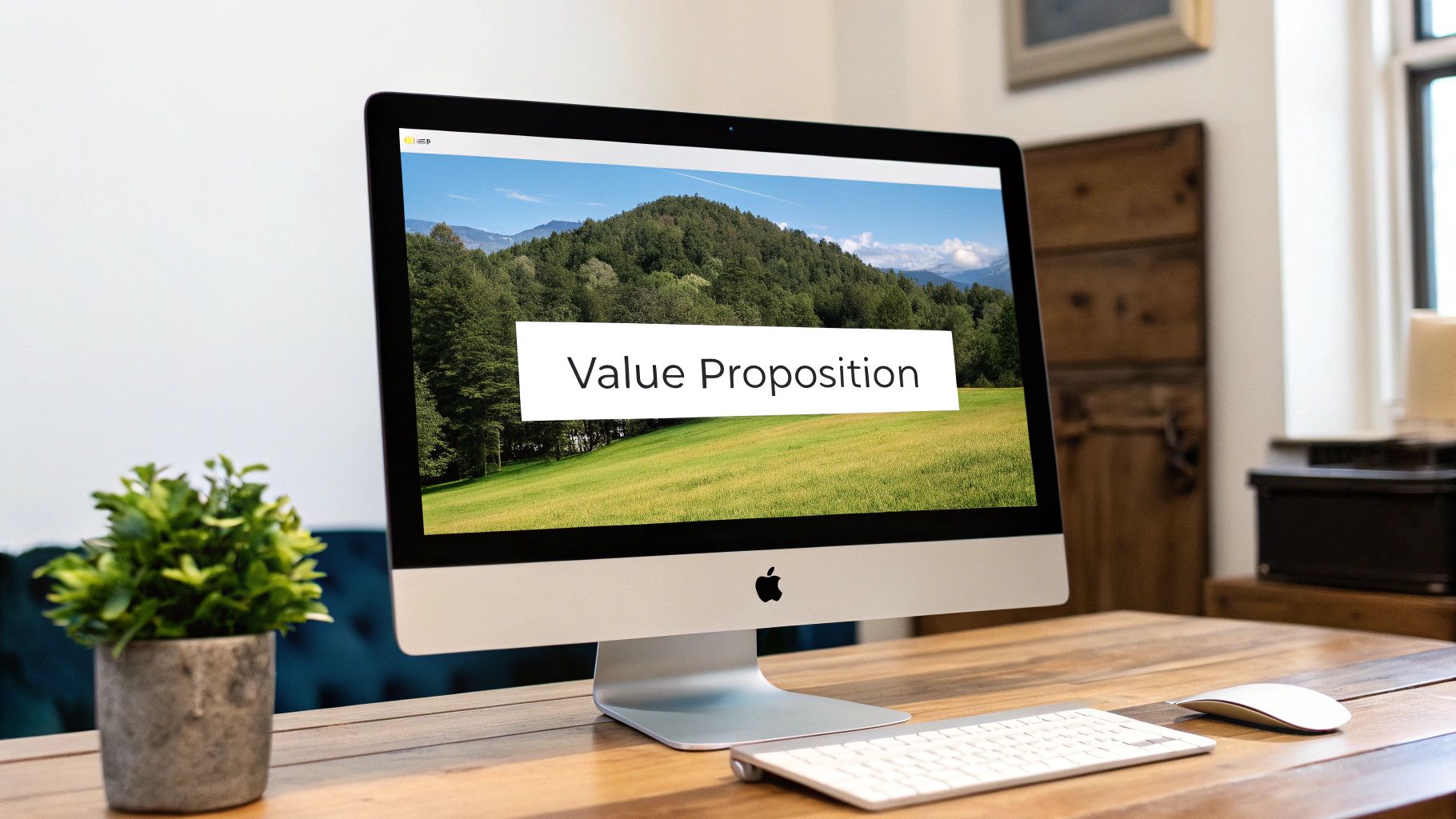October 4, 2025
9 Conversion Rate Optimization Best Practices for 2025


Getting traffic is one thing, but turning those visitors into loyal customers is where the real magic happens. If your website feels more like a revolving door than a sales machine, you're in the right place. It’s easy to get lost in analytics, but improving your conversion rate doesn't have to be a guessing game. The key is to systematically test and refine your user experience, making it as easy and compelling as possible for visitors to take action.
This isn't just another list of generic tips. We're diving deep into nine proven conversion rate optimization best practices that go beyond the basics, covering everything from A/B testing and value propositions to page speed and personalization. For e-commerce businesses using specific platforms, you can even explore targeted strategies to improve your Shopify conversion rate to further boost sales.
Forget vague advice. We’re giving you actionable strategies, real-world examples, and the 'why' behind what works. You’ll walk away with a clear roadmap to implement changes that actually move the needle. Let's get started on boosting your bottom line, one optimization at a time.
1. A/B Testing and Statistical Significance
A/B testing, also known as split testing, is the bread and butter of effective conversion rate optimization best practices. Think of it as a scientific experiment for your marketing. You create two (or more) versions of a single element, like a headline or a call-to-action button, and show them to different segments of your audience simultaneously. The goal is simple: to see which version gets you more clicks, sign-ups, or sales. This method removes guesswork and lets you make data-driven decisions instead of relying on gut feelings.

This foundational CRO technique allows you to systematically improve your user experience and conversion funnels, one element at a time. Giants like Netflix constantly test thumbnail images to see which one entices more viewers to click, while HubSpot famously increased conversions by 24% just by testing the color of a CTA button. It’s all about controlled, measurable improvements.
How to Implement A/B Testing
Ready to get started? Here are some actionable tips:
- Test One Variable at a Time: Want to know if a red button outperforms a green one? Don't change the headline in the same test. Isolating your variable is the only way to know for sure what caused the change in performance.
- Run Tests Long Enough: Don't call a test after just one day. You need to run it for at least one full business cycle (usually 1-2 weeks) to account for daily fluctuations in user behavior and gather enough data.
- Demand Statistical Significance: Don’t just eyeball the results. Use a sample size calculator and aim for a statistical confidence level of at least 95%. This ensures your results aren't just due to random chance. Tools like Optimizely and Google Optimize have made this process much more accessible.
- Document Everything: Keep a detailed log of every test you run, including your hypothesis, the variants, the duration, and the outcome. This "cookbook" of insights becomes an invaluable asset for future optimization efforts.
2. Clear and Compelling Value Propositions
Your value proposition is the promise you make to your customers. It's a crystal-clear statement that explains how your product solves a problem, what specific benefits they'll get, and why they should choose you over the competition. This is often the first thing a visitor sees on your site, and it plays a massive role in their decision to either stay and explore or hit the back button. Nail this, and you've won half the battle.

This element is a cornerstone of conversion rate optimization best practices because it immediately answers the visitor's most important question: "What's in it for me?" Think of Slack's famous "Be more productive at work with less effort." It's not about features; it's about the outcome. A strong value proposition connects with the user's needs instantly, building trust and clarifying your purpose before they even scroll.
How to Craft a Winning Value Proposition
Ready to sharpen your message? Here are some actionable tips:
- Focus on Outcomes, Not Features: Customers don't buy a drill; they buy a hole in the wall. Instead of listing technical specs, communicate the end benefit your product or service delivers to them.
- Use Your Customer's Language: Dive into customer interviews, surveys, and reviews. Borrow the exact words and phrases your ideal customers use to describe their problems and desired solutions. This makes your message resonate deeply.
- Be Specific and Quantifiable: Vague promises are weak. If you can, use numbers to make your claim more tangible. For example, "Save up to 3 hours per week on admin tasks" is much stronger than "Save time."
- Place It Prominently: Your primary value proposition should be impossible to miss. Position it "above the fold" on your homepage and key landing pages so it's the first thing visitors read.
3. Optimized Call-to-Action (CTA) Design and Placement
Your Call-to-Action (CTA) is the most important element on your page; it's the gateway to conversion. Optimizing its design, wording, and placement is a fundamental conversion rate optimization best practice because it directly tells users what to do next. Think of your CTA as the bridge between a visitor's interest and the action you want them to take, like making a purchase or signing up for a newsletter. Small changes can lead to huge results.

This isn't just theory; it's a proven strategy. HubSpot famously increased conversions by 21% simply by changing their CTA text from a generic "Submit" to a value-focused "Get My Free Ebook." Similarly, Netflix uses the enticing "Join Free for a Month" instead of a bland "Sign Up" to lower the barrier to entry. Your CTA isn't just a button; it's a powerful psychological trigger that, when optimized, can dramatically improve your conversion funnel's performance.
How to Implement CTA Optimization
Ready to make your buttons work harder for you? Here are some actionable tips:
- Use Action-Oriented, First-Person Language: Ditch passive words like "Submit." Instead, use compelling phrases that put the user in control, like "Get My Free Trial" or "Reserve My Spot." This creates a sense of ownership and clarifies the benefit.
- Create Urgency and Scarcity: Motivate immediate action by incorporating time-sensitive language. Phrases like "Shop the Sale - Ends Tonight!" or "Only 3 Spots Left!" can effectively combat user hesitation and boost your click-through rate.
- Ensure High Visibility: Your primary CTA should be impossible to miss. Place it "above the fold" so users don't have to scroll to find it. Use contrasting colors that make the button pop from the background and consider adding subtle directional cues, like arrows, to draw the eye.
- Test Everything: Don't assume you know what works best. A/B test your button color, size, shape, and copy. Test a button versus a simple text link. Each audience is different, and only data can tell you what resonates most effectively with yours.
4. Landing Page Optimization and Message Matching
Your landing page is where the conversion magic happens, but only if it delivers on the promise made by your ad, email, or social post. Landing page optimization is all about creating a focused, distraction-free page with a single goal. The key to making it work is message matching: ensuring the headline, copy, and imagery on your page directly reflect the source that brought the visitor there. This creates a seamless, reassuring experience that tells users they’re in the right place.

This alignment between ad and landing page is one of the most powerful conversion rate optimization best practices because it reduces friction and confusion. When a user clicks an ad for "blue running shoes" and lands on a page with a headline that says "The Best Blue Running Shoes," their confidence skyrockets. Companies like Unbounce build their entire business around this concept, creating unique landing pages for every single ad campaign to maximize relevance and conversions.
How to Implement Landing Page Optimization
Here’s how to nail this crucial CRO tactic:
- Remove Main Navigation: Your landing page has one job. Remove the main menu and other exit links to keep visitors focused on the call-to-action and prevent them from wandering off.
- Match Ad Keywords to Headlines: Use the exact same keywords from your ads in your landing page headline. This instant recognition confirms the page’s relevance and improves your ad Quality Score. For more on this, check out our guide to PPC campaign optimization on keywordme.io.
- Include Relevant Social Proof: Add testimonials, reviews, or logos from customers who are similar to your target audience. This builds trust and validates the visitor’s decision to click.
- Optimize for a Mobile-First Experience: Most traffic comes from mobile devices. Ensure your landing page loads quickly and is easy to navigate on a small screen, with a thumb-friendly CTA button.
5. Social Proof and Trust Signals Integration
People are hardwired to follow the crowd. Social proof leverages this psychological principle by showing visitors that other people are already choosing, using, and loving your product or service. This technique, popularized by psychologists like Robert Cialdini, reduces friction and anxiety by reassuring potential customers they're making a good decision. When combined with trust signals like security badges or guarantees, it's one of the most powerful conversion rate optimization best practices.
This strategy works by building credibility and validating a visitor’s choice at critical decision points. Basecamp does this masterfully by stating they are "Trusted by millions," while Booking.com creates urgency by showing how many people have recently booked a specific hotel. It’s all about showcasing popularity and trustworthiness to make the "yes" feel like the natural, safe choice for a new user.
How to Implement Social Proof and Trust Signals
Ready to build visitor confidence? Here are some actionable tips:
- Be Specific with Numbers: Don’t just say "many customers." Use concrete figures like "Over 15,432 sold this month" or "Join 50,000+ subscribers." Specificity is far more believable and impactful than vague claims.
- Showcase Authentic Testimonials: Include high-quality photos and real names (with permission) alongside customer testimonials. A face adds a powerful layer of authenticity that text alone can't match.
- Place Signals Strategically: Position your social proof and trust badges near key conversion points. Place customer logos near a demo request form or security seals like Norton or McAfee right on the checkout page to quell last-minute fears.
- Use Relevant Trust Badges: Display industry-specific awards, press mentions (e.g., "As seen on Forbes"), or relevant security certifications. The key is relevance; an SSL badge matters more on a payment page than a blog post.
6. Mobile-First Responsive Design
Gone are the days when mobile was just an afterthought. Mobile-first responsive design flips the traditional web design process on its head. Instead of designing for a large desktop screen and then trying to cram everything onto a smaller device, you start with the mobile experience and progressively enhance it for larger screens. This approach is one of the most critical conversion rate optimization best practices today, as mobile traffic consistently outpaces desktop in many industries.
This strategy forces you to prioritize what truly matters. By focusing on the smallest screen first, you strip away non-essential elements and zero in on core content and calls-to-action, creating a leaner, faster, and more user-friendly experience for everyone. Companies that nail this see huge returns; Pinterest, for example, saw user engagement jump by 40% after a mobile-first redesign, and Starbucks' focus on mobile has been a key driver of its sales growth.
How to Implement Mobile-First Design
Ready to put your mobile users first? Here are some actionable tips:
- Design for Thumbs: Structure your layout so key navigation elements and buttons are within the "thumb zone" at the bottom and center of the screen. This makes one-handed use much easier.
- Simplify Forms: Minimize the number of form fields and use HTML5 input types to trigger the correct mobile keyboard (e.g., a number pad for phone numbers). Every removed field reduces friction.
- Prioritize Readability and Tappability: Use larger font sizes for readability and ensure buttons and links have a minimum touch target size of 44x44 pixels to prevent frustrating mis-taps. Understanding the principles of mobile-first design is key to getting these details right.
- Test on Real Devices: Don't just rely on browser emulators. Testing your site on actual iPhones and Android devices is the only way to truly understand the user experience and catch device-specific glitches.
7. Form Optimization and Friction Reduction
Forms are the final hurdle between you and a lead, and every extra field or confusing question is a reason for a user to bounce. Form optimization is the art of making this final step as painless as possible. It involves reducing friction by asking for only what you absolutely need, improving usability with a clean layout, and building trust to convince users to click that final "submit" button. This is one of the most direct and high-impact conversion rate optimization best practices you can implement.
This practice is all about respecting the user's time and effort. When Expedia removed a single, optional "Company Name" field from their booking form, they saw an additional $12 million in annual profit. Likewise, Quicksprout saw a 26% increase in leads simply by cutting fields from their contact form. These examples prove that a shorter, simpler form almost always leads to a higher completion rate.
How to Implement Form Optimization
Ready to streamline your forms? Here are some actionable tips:
- Ask for the Bare Minimum: Audit every field on your form. Do you really need their phone number right now? Could you get their company size later? Each field you remove is a potential boost to your conversion rate.
- Use a Single-Column Layout: Research from form experts like Luke Wroblewski shows that single-column forms are completed faster and with less confusion than multi-column layouts. It provides a clear, linear path for the user to follow.
- Implement Inline Validation: Don't wait until a user submits the form to tell them they made an error. Use inline validation to provide immediate feedback, showing a green checkmark for correct entries and a red X for errors as they type.
- Group Related Fields: If your form must be long, group related fields into logical sections (e.g., "Contact Information," "Shipping Details"). This makes the form feel less intimidating and easier to process.
- Leverage Smart Defaults: Use information you already have, like geolocation, to pre-fill fields like "Country" or "State." The less a user has to type, the more likely they are to complete the form.
8. Page Speed and Performance Optimization
In the world of conversion rate optimization best practices, speed isn't just a feature; it's a fundamental requirement. Page speed optimization is the process of making your website load as quickly as possible. In an age of instant gratification, every millisecond counts. A slow-loading site frustrates users, leading to high bounce rates and lost revenue before they even see your offer. This makes performance a silent conversion killer or a powerful conversion booster.
Think of it this way: a slow page is like a long queue at a physical store. Most potential customers will simply turn around and leave. The data backs this up decisively. Amazon famously calculated that a mere 100-millisecond delay could cost them 1% in sales, while Walmart saw a 2% conversion rate increase for every one-second improvement in load time. Optimizing for speed is a direct investment in user experience and your bottom line.
How to Implement Page Speed Optimization
Ready to put the pedal to the metal? Here are some actionable tips:
- Optimize Your Images: Large, uncompressed images are often the biggest culprits. Use modern formats like WebP, resize images to their correct display dimensions before uploading, and use compression tools to reduce file size without sacrificing quality.
- Minimize HTTP Requests: Every element on your page (images, scripts, CSS files) requires a separate HTTP request. Combine CSS and JavaScript files, use CSS sprites for common images, and eliminate unnecessary third-party scripts to reduce the total number of requests.
- Leverage Browser Caching: Configure your server to tell browsers to store static files locally. This means on subsequent visits, the user's browser can load the page without having to re-download every single asset, dramatically speeding up the experience.
- Use a Content Delivery Network (CDN): A CDN stores copies of your site on servers around the globe. When a user visits, content is delivered from the server closest to them, significantly reducing latency and load times for a global audience.
- Audit with Google PageSpeed Insights: This free tool from Google is your best friend. It analyzes your site's performance on both mobile and desktop and provides a prioritized list of specific recommendations to improve your speed. Start here to identify your biggest opportunities.
9. Personalization and Behavioral Targeting
In a world saturated with generic marketing messages, personalization cuts through the noise. This approach involves tailoring content, offers, and entire user experiences to individuals based on their behavior, demographics, or past interactions with your brand. Instead of a one-size-fits-all website, visitors see content that feels uniquely relevant to them, which is a cornerstone of modern conversion rate optimization best practices.
This strategy makes the user journey feel less like a sales pitch and more like a helpful conversation. Think of how Amazon shows you products "related to items you've viewed" or how Netflix customizes its homepage based on your viewing history. By presenting the right message to the right person at the right time, you dramatically increase the likelihood of a conversion because you're directly addressing their needs and interests.
How to Implement Personalization
Ready to create more relevant user experiences? Here are some actionable tips:
- Start with Simple Segmentation: You don't need complex AI to begin. Start by creating different experiences for new vs. returning visitors. Show first-time visitors an introductory offer, while returning users might see a message about new arrivals.
- Leverage Dynamic Content: Use tools to dynamically change headlines, images, or calls-to-action based on a user's location, traffic source, or on-site behavior. For instance, show a different hero image to someone who arrived from a Facebook ad versus a Google search.
- Use Progressive Profiling: Instead of hitting new leads with a massive form, collect information over time. Ask for their name and email on the first visit, then ask for their company size or job title on their next visit. This builds a customer profile without creating friction. You can gain deeper insights on this with our guide on Google Ads audience targeting.
- Respect User Privacy: Personalization is powerful, but it must be transparent. Always provide clear opt-out options and be upfront about the data you're collecting. Building trust is essential for long-term success.
Best Practices Comparison Matrix for Conversion Rate Optimization
Start Optimizing and Watch Your Conversions Grow
We’ve covered a lot of ground, from the statistical rigor of A/B testing to the psychological power of a well-placed trust signal. It can feel like a mountain of tasks, but the journey to a higher conversion rate doesn't happen overnight. It’s not about overhauling your entire website in one weekend. Instead, it’s about making a commitment to a continuous cycle of improvement, one hypothesis at a time.
Think of it this way: your website is a living conversation with your audience. Right now, it might be a bit one-sided. By implementing these conversion rate optimization best practices, you start listening to what your users are actually doing, not just what you think they want. Each test, each tweak, and each data point is a response from them, telling you what’s working and what’s sending them running for the exit button.
The most powerful takeaway from this guide isn't a single tactic, but a shift in mindset. True optimization is an ongoing discipline, not a one-and-done project.
Your Action Plan for Higher Conversions
Ready to stop guessing and start growing? Here’s how to put these ideas into action:
- Pick Your Battles: Don't try to optimize everything at once. Start with the low-hanging fruit. Is your form ridiculously long? That’s a great place to begin. Is your mobile experience clunky? Focus your energy there first. Choose one or two high-impact areas from our list.
- Form a Hypothesis: Before you change a single pixel, state your assumption. For example: "By changing the CTA button color from blue to orange, we believe we will increase sign-ups because orange stands out more against our background." This frames your test and makes the results meaningful.
- Test, Measure, and Repeat: Run your A/B test until you reach statistical significance. Whether your hypothesis was right or wrong, you’ve learned something valuable about your audience. Take that insight, form a new hypothesis, and go again.
Mastering this iterative process is what separates stagnant businesses from those that achieve exponential growth. Every successful test builds momentum, creating a flywheel effect that not only boosts your bottom line but also delivers a genuinely better experience for your customers. You're not just tricking people into clicking; you're removing friction and making it easier for them to get what they came for. Ultimately, that's what building a successful brand is all about.
And remember, your optimization efforts are only as good as the traffic you send to your pages. Ensure every click is from a qualified, high-intent user by starting with a rock-solid Google Ads foundation. Keywordme helps you clean up your campaigns and identify the exact keywords that drive conversions, giving your beautifully optimized pages the high-quality audience they deserve.


.svg)